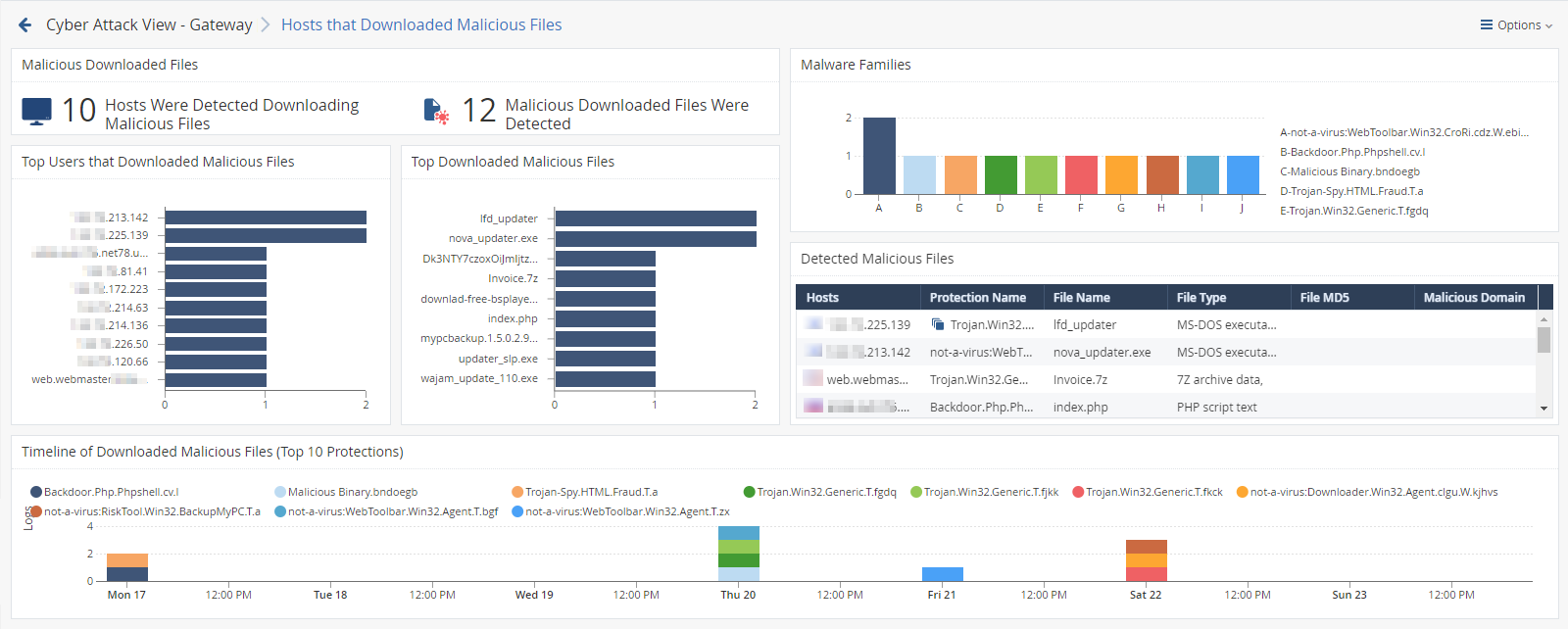Hosts that Downloaded Malicious Files (Attacks Allowed By Policy)
Description
In the main Cyber Attack View, in the Attacks Allowed By Policy section, double-click Hosts that Downloaded Malicious Files.
Note - Select the desired report period in the top left corner of this view. For example, Last 7 Days, This Month, and so on.
This drill-down view shows a summary of attacks that used malicious files.
This drill-down view shows all the malicious files caught by Check Point Threat Prevention's multi-layer protections.
Drill-Down View
This is an obfuscated example of the drill-down view:

To see the applicable logs (the next drill-down level), double-click on a value.
Available Widgets
Widgets available in the drill-down view:
|
Widget |
Type |
Description |
|---|---|---|
|
Malicious Downloaded Files |
Infographic |
Shows:
|
|
Malware Families |
Chart |
Shows the top downloaded malware families (based on Check Point ThreatWiki and Check Point Research). Different colors show different families. |
|
Top Users that Downloaded Malicious Files |
Chart |
Shows hosts that downloaded the largest number of malicious files. The chart is sorted by the number of downloaded malicious files. |
|
Top Downloaded Malicious Files |
Chart |
Shows the number of downloads for the top malicious files. The chart is sorted by the number of appearances of downloaded malicious files. |
|
Detected Malicious Files |
Table |
Shows the downloaded malicious files. Shows:
|
|
Timeline of Downloaded Malicious Files (Top 10 Protections) |
Timeline |
Shows the number of logs for downloaded malicious files. Different colors show different files. |
Widget Query
In addition to the Default Query, the widget runs this query:
|
|
Best Practices
Best practices against malicious files:
-
In the Attacks Allowed By Policy section, click Hosts that Downloaded Malicious Files.
-
In the Malicious Downloaded Files widget, double-click the Hosts Were Detected Downloading Malicious Files infographic.
-
Locate events from the IPS Software Blade only.
-
Examine the IPS protections currently configured in Detect mode and decide if you can change them to Prevent mode.
To configure IPS protections in SmartConsole: From the left navigation panel, click Security Policies> click the Threat Prevention section > at the bottom, click IPS Protections > edit the applicable IPS protection > install the Threat Prevention Policy.
-
-
In the Threat Prevention logs from the Security Gateway, examine the Description field (see Log Fields) to see if the Anti-Virus Software Blade work is in the Background or Hold mode.
In addition, read sk74120: Why Anti-Bot and Anti-Virus connections may be allowed even in Prevent mode.